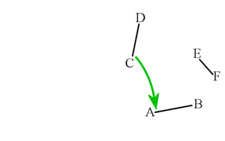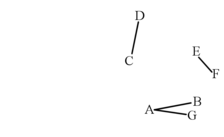In this chapter, we will show how to construct a triangle from three segments. The construction is based on Book I, proposition 22
The construction
Given three line segments , and we build a triangle whose sides equal the segments.
- Copy the line to point A.

If you have forgotten how to do this, follow the instructions in the previous section. Your construction should look like the grey lines in the picture below. Call the new line
It's a good idea to erase your construction lines now, so all that's left are the four line segments shown below.
- Copy the line to point B

Your construction should look like the grey lines in the picture below. Call the new line
- Draw the circle , whose center is A and radius is .
- Draw the circle , whose center is B and radius is .
- Let J be an intersection point of and .

- Draw a line .
- Draw a line .

Claim
The sides of the triangle equal to , and .
Proof
- The segment is a side of the triangle and equal to itself.
- The segment is equal to because they are both radii of circle. And because it was copied, =. Therefore is also equal to
- The segment is equal to because they are both radii of circle. And because it was copied, =. Therefore is also equal to
- Hence the sides of the triangle are equal to , and .
Testing the procedure
- Draw a line of some length.
- Copy the line to an arbitrary point C and get .
- Draw a line such that it length is three times the length of . (We didn't specify how to construct such a segment and we give it as an exercise. Use chapter Copy the line as a guide for the solution.
- Construct a triangle from , and .
Why you couldn't construct the triangle in the test?
The reason we couldn’t build the triangle in the test is that the circles we constructed did not intersect. One cannot use any three segment to construct a triangle. The length of the segments must obey a condition called “The triangle inequality”. The triangle inequality states that any of the segments should be shorter that the sum of the length of the other two segments. If one of the segments is longer the circles do not intersect. If one segment equals to the sum of the other two, we get a line instead of a triangle.
Therefore, the construction is correct but one should condition the segments on which it can be applied. Note that the original construction was conditioned by Euclid, hence there is no error in the construction or in its proof.